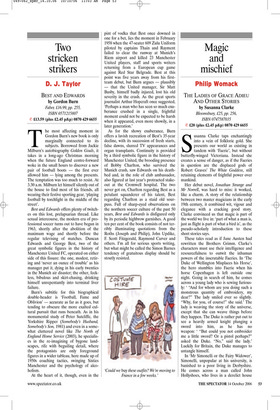Two stricken strikers
D. J. Taylor
BEST AND EDWARDS by Gordon Burn Faber, £16.99, pp. 255, ISBN 0571215807 ✆ £13.59 (plus £2.45 p&p) 0870 429 6655 The most affecting moment in Gordon Burn’s new book is only marginally connected to its subjects. Borrowed from Jackie Milburn’s autobiography Golden Goals, it takes in a long-ago Christmas morning when the future England centre-forward woke in the small hours to discover a new pair of football boots — the first ever allowed him — lying among the presents. The temptation was too much to resist. At 3.30 a.m. Milburn let himself silently out of the house to find most of his friends, all wearing their festive sporting gear, ‘playing football by torchlight in the middle of the street’.
Best and Edwards offers plenty of twitches on this lost, prelapsarian thread. Like sexual intercourse, the modern era of professional soccer turns out to have begun in 1963, shortly after the abolition of the maximum wage and shortly before the regular televising of matches. Duncan Edwards and George Best, two of the great symbolic figures in the history of Manchester United FC, operated on either side of this fissure: the one, modest, retiring and ‘never an ounce of trouble’ as his manager put it, dying in his early twenties in the Munich air disaster; the other, feckless, bibulous and skirt-chasing, drinking himself unrepentantly into terminal liver failure.
Burn’s subtitle for this biographical double-header is ‘Football, Fame and Oblivion’ — accurate as far as it goes, but tending to obscure the more exalted cultural pursuit that runs beneath. As in his monumental study of Peter Sutcliffe, the Yorkshire Ripper (Somebody’s Husband, Somebody’s Son, 1981) and even in a somewhat cluttered novel like The North of England Home Service (2003), he specialises in the re-imagining of bygone landscapes, rife with beguiling detail, where the protagonists are only foreground figures in a wider tableau, here made up of 1950s coaching tactics, swinging Sixties Manchester and the psychology of alcoholism.
At the heart of it, though, even in the pint of vodka that Best once downed in one for a bet, lies the moment in February 1958 when the 47-seater 609 Zulu Uniform piloted by captains Thain and Rayment failed to clear the runway at Munich’s Riem airport and killed 23 Manchester United players, staff and sports writers returning from a European cup game against Red Star Belgrade. Best at this point was five years away from his firstteam debut, but Burn argues — plausibly — that the United manager, Sir Matt Busby, himself badly injured, lost his old severity in the crash. As the great sports journalist Arthur Hopcraft once suggested, ‘Perhaps a man who has seen so much exuberance crushed in a single, frightful moment could not be expected to be harsh when it appeared, even more showily, in a later generation.’ As for the showy exuberance, Burn offers a lavish recreation of Best’s 35-year decline, with its succession of fresh starts, false dawns, slurred TV appearances and organ transplants. Continuity is provided by a third symbolic figure in the history of Manchester United, the brooding presence of Bobby Charlton, who survived the Munich crash, saw Edwards on his deathbed and, in the role of club ambassador, also figured at last year’s protracted stakeout at the Cromwell hospital. The two never got on, Charlton regarding Best as a petulant squanderer of his talent, Best regarding Charlton as a staid old sourpuss. Full of sharp-eyed observations on the northern soccer culture of the past 50 years, Best and Edwards is disfigured only by its periodic highbrow garnishes. A good ten per cent of the book consists of not terribly illuminating quotations from the Roths (Joseph and Philip), John Updike, F. Scott Fitzgerald, Raymond Carver and others. I’m all for serious sports writing, but what might be called the Simon Barnes tendency of gratuitous display should be stoutly resisted.


































































































 Previous page
Previous page